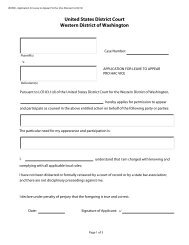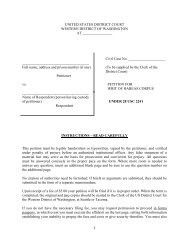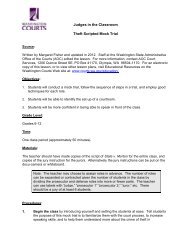Model Stipulated Protective Order - Western District of Washington
Model Stipulated Protective Order - Western District of Washington
Model Stipulated Protective Order - Western District of Washington
Create successful ePaper yourself
Turn your PDF publications into a flip-book with our unique Google optimized e-Paper software.
1<br />
2<br />
3<br />
4<br />
5<br />
6<br />
7<br />
8<br />
9<br />
10<br />
,<br />
UNITED STATES DISTRICT COURT<br />
WESTERN DISTRICT OF WASHINGTON<br />
CASE NO.<br />
11<br />
12<br />
v.<br />
Plaintiff,<br />
MODEL STIPULATED<br />
PROTECTIVE ORDER<br />
13<br />
[Defendant],<br />
14<br />
Defendant.<br />
15<br />
16<br />
17<br />
18<br />
19<br />
20<br />
21<br />
22<br />
23<br />
24<br />
1. PURPOSES AND LIMITATIONS<br />
Discovery in this action is likely to involve production <strong>of</strong> confidential, proprietary, or<br />
private information for which special protection may be warranted. Accordingly, the parties<br />
hereby stipulate to and petition the court to enter the following <strong>Stipulated</strong> <strong>Protective</strong> <strong>Order</strong>. The<br />
parties acknowledge that this agreement is consistent with LCR 26(c). It does not confer blanket<br />
protection on all disclosures or responses to discovery, the protection it affords from public<br />
disclosure and use extends only to the limited information or items that are entitled to<br />
confidential treatment under the applicable legal principles, and it does not presumptively entitle<br />
parties to file confidential information under seal.<br />
MODEL STIPULATED PROTECTIVE ORDER- 1
1<br />
2<br />
3<br />
4<br />
5<br />
6<br />
7<br />
8<br />
9<br />
10<br />
11<br />
12<br />
13<br />
14<br />
15<br />
16<br />
17<br />
18<br />
19<br />
20<br />
21<br />
22<br />
2. “CONFIDENTIAL” MATERIAL<br />
“Confidential” material shall include the following documents and tangible things<br />
produced or otherwise exchanged: [The parties must include a list <strong>of</strong> specific documents such as<br />
“company’s customer list” or “plaintiff’s medical records;” do not list broad categories <strong>of</strong><br />
documents such as “sensitive business material”].<br />
3. SCOPE<br />
The protections conferred by this agreement cover not only confidential material (as<br />
defined above), but also (1) any information copied or extracted from confidential material; (2)<br />
all copies, excerpts, summaries, or compilations <strong>of</strong> confidential material; and (3) any testimony,<br />
conversations, or presentations by parties or their counsel that might reveal confidential material.<br />
However, the protections conferred by this agreement do not cover information that is in the<br />
public domain or becomes part <strong>of</strong> the public domain through trial or otherwise.<br />
4. ACCESS TO AND USE OF CONFIDENTIAL MATERIAL<br />
4.1 Basic Principles. A receiving party may use confidential material that is disclosed<br />
or produced by another party or by a non-party in connection with this case only for prosecuting,<br />
defending, or attempting to settle this litigation. Confidential material may be disclosed only to<br />
the categories <strong>of</strong> persons and under the conditions described in this agreement. Confidential<br />
material must be stored and maintained by a receiving party at a location and in a secure manner<br />
that ensures that access is limited to the persons authorized under this agreement.<br />
4.2 Disclosure <strong>of</strong> “CONFIDENTIAL” Information or Items. Unless otherwise<br />
ordered by the court or permitted in writing by the designating party, a receiving party may<br />
disclose any confidential material only to:<br />
23<br />
24<br />
MODEL STIPULATED PROTECTIVE ORDER- 2
1<br />
2<br />
3<br />
4<br />
5<br />
6<br />
7<br />
8<br />
9<br />
10<br />
11<br />
12<br />
13<br />
14<br />
15<br />
16<br />
17<br />
18<br />
19<br />
20<br />
21<br />
22<br />
23<br />
(a) the receiving party’s counsel <strong>of</strong> record in this action, as well as employees <strong>of</strong><br />
counsel to whom it is reasonably necessary to disclose the information for this litigation;<br />
(b) the <strong>of</strong>ficers, directors, and employees (including in house counsel) <strong>of</strong> the<br />
receiving party to whom disclosure is reasonably necessary for this litigation, unless the parties<br />
agree that a particular document or material produced is for Attorney’s Eyes Only and is so<br />
designated;<br />
(c) experts and consultants to whom disclosure is reasonably necessary for this<br />
litigation and who have signed the “Acknowledgment and Agreement to Be Bound” (Exhibit A);<br />
(d) the court, court personnel, and court reporters and their staff;<br />
(e) copy or imaging services retained by counsel to assist in the duplication <strong>of</strong><br />
confidential material, provided that counsel for the party retaining the copy or imaging service<br />
instructs the service not to disclose any confidential material to third parties and to immediately<br />
return all originals and copies <strong>of</strong> any confidential material;<br />
(f) during their depositions, witnesses in the action to whom disclosure is<br />
reasonably necessary and who have signed the “Acknowledgment and Agreement to Be Bound”<br />
(Exhibit A), unless otherwise agreed by the designating party or ordered by the court. Pages <strong>of</strong><br />
transcribed deposition testimony or exhibits to depositions that reveal confidential material must<br />
be separately bound by the court reporter and may not be disclosed to anyone except as permitted<br />
under this agreement;<br />
(g) the author or recipient <strong>of</strong> a document containing the information or a<br />
custodian or other person who otherwise possessed or knew the information.<br />
4.3 Filing Confidential Material. Before filing confidential material or discussing or<br />
referencing such material in court filings, the filing party shall confer with the designating party<br />
24<br />
MODEL STIPULATED PROTECTIVE ORDER- 3
1<br />
2<br />
3<br />
4<br />
5<br />
6<br />
7<br />
8<br />
9<br />
10<br />
11<br />
12<br />
13<br />
14<br />
15<br />
16<br />
17<br />
18<br />
19<br />
20<br />
21<br />
22<br />
23<br />
to determine whether the designating party will remove the confidential designation, whether the<br />
document can be redacted, or whether a motion to seal or stipulation and proposed order is<br />
warranted. Local Civil Rule 5(g) sets forth the procedures that must be followed and the<br />
standards that will be applied when a party seeks permission from the court to file material under<br />
seal.<br />
5. DESIGNATING PROTECTED MATERIAL<br />
5.1 Exercise <strong>of</strong> Restraint and Care in Designating Material for Protection. Each party<br />
or non-party that designates information or items for protection under this agreement must take<br />
care to limit any such designation to specific material that qualifies under the appropriate<br />
standards. The designating party must designate for protection only those parts <strong>of</strong> material,<br />
documents, items, or oral or written communications that qualify, so that other portions <strong>of</strong> the<br />
material, documents, items, or communications for which protection is not warranted are not<br />
swept unjustifiably within the ambit <strong>of</strong> this agreement.<br />
Mass, indiscriminate, or routinized designations are prohibited. Designations that are<br />
shown to be clearly unjustified or that have been made for an improper purpose (e.g., to<br />
unnecessarily encumber or delay the case development process or to impose unnecessary<br />
expenses and burdens on other parties) expose the designating party to sanctions.<br />
If it comes to a designating party’s attention that information or items that it designated<br />
for protection do not qualify for protection, the designating party must promptly notify all other<br />
parties that it is withdrawing the mistaken designation.<br />
5.2 Manner and Timing <strong>of</strong> Designations. Except as otherwise provided in this<br />
agreement (see, e.g., second paragraph <strong>of</strong> section 5.2(a) below), or as otherwise stipulated or<br />
ordered, disclosure or discovery material that qualifies for protection under this agreement must<br />
24<br />
MODEL STIPULATED PROTECTIVE ORDER- 4
1<br />
2<br />
3<br />
4<br />
5<br />
6<br />
7<br />
8<br />
9<br />
10<br />
11<br />
12<br />
13<br />
14<br />
15<br />
16<br />
17<br />
18<br />
19<br />
20<br />
21<br />
22<br />
23<br />
be clearly so designated before or when the material is disclosed or produced.<br />
(a) Information in documentary form: (e.g., paper or electronic documents and<br />
deposition exhibits, but excluding transcripts <strong>of</strong> depositions or other pretrial or trial proceedings),<br />
the designating party must affix the word “CONFIDENTIAL” to each page that contains<br />
confidential material. If only a portion or portions <strong>of</strong> the material on a page qualifies for<br />
protection, the producing party also must clearly identify the protected portion(s) (e.g., by<br />
making appropriate markings in the margins).<br />
(b) Testimony given in deposition or in other pretrial or trial proceedings: the<br />
parties must identify on the record, during the deposition, hearing, or other proceeding, all<br />
protected testimony, without prejudice to their right to so designate other testimony after<br />
reviewing the transcript. Any party or non-party may, within fifteen days after receiving a<br />
deposition transcript, designate portions <strong>of</strong> the transcript, or exhibits thereto, as confidential.<br />
(c) Other tangible items: the producing party must affix in a prominent place on<br />
the exterior <strong>of</strong> the container or containers in which the information or item is stored the word<br />
“CONFIDENTIAL.” If only a portion or portions <strong>of</strong> the information or item warrant protection,<br />
the producing party, to the extent practicable, shall identify the protected portion(s).<br />
5.3 Inadvertent Failures to Designate. If timely corrected, an inadvertent failure to<br />
designate qualified information or items does not, standing alone, waive the designating party’s<br />
right to secure protection under this agreement for such material. Upon timely correction <strong>of</strong> a<br />
designation, the receiving party must make reasonable efforts to ensure that the material is<br />
treated in accordance with the provisions <strong>of</strong> this agreement.<br />
6. CHALLENGING CONFIDENTIALITY DESIGNATIONS<br />
6.1 Timing <strong>of</strong> Challenges. Any party or non-party may challenge a designation <strong>of</strong><br />
24<br />
MODEL STIPULATED PROTECTIVE ORDER- 5
1<br />
2<br />
3<br />
4<br />
5<br />
6<br />
7<br />
8<br />
9<br />
10<br />
11<br />
12<br />
13<br />
14<br />
15<br />
16<br />
17<br />
18<br />
19<br />
20<br />
21<br />
22<br />
23<br />
24<br />
confidentiality at any time. Unless a prompt challenge to a designating party’s confidentiality<br />
designation is necessary to avoid foreseeable, substantial unfairness, unnecessary economic<br />
burdens, or a significant disruption or delay <strong>of</strong> the litigation, a party does not waive its right to<br />
challenge a confidentiality designation by electing not to mount a challenge promptly after the<br />
original designation is disclosed.<br />
6.2 Meet and Confer. The parties must make every attempt to resolve any dispute<br />
regarding confidential designations without court involvement. Any motion regarding<br />
confidential designations or for a protective order must include a certification, in the motion or in<br />
a declaration or affidavit, that the movant has engaged in a good faith meet and confer<br />
conference with other affected parties in an effort to resolve the dispute without court action. The<br />
certification must list the date, manner, and participants to the conference. A good faith effort to<br />
confer requires a face-to-face meeting or a telephone conference.<br />
6.3 Judicial Intervention. If the parties cannot resolve a challenge without court<br />
intervention, the designating party may file and serve a motion to retain confidentiality under<br />
Local Civil Rule 7 (and in compliance with Local Civil Rule 5(g), if applicable). The burden <strong>of</strong><br />
persuasion in any such motion shall be on the designating party. Frivolous challenges, and those<br />
made for an improper purpose (e.g., to harass or impose unnecessary expenses and burdens on<br />
other parties) may expose the challenging party to sanctions. All parties shall continue to<br />
maintain the material in question as confidential until the court rules on the challenge.<br />
7. PROTECTED MATERIAL SUBPOENAED OR ORDERED PRODUCED IN OTHER<br />
LITIGATION<br />
If a party is served with a subpoena or a court order issued in other litigation that compels<br />
disclosure <strong>of</strong> any information or items designated in this action as “CONFIDENTIAL,” that<br />
party must:<br />
MODEL STIPULATED PROTECTIVE ORDER- 6
1<br />
2<br />
3<br />
4<br />
5<br />
6<br />
7<br />
8<br />
9<br />
10<br />
11<br />
12<br />
13<br />
14<br />
15<br />
16<br />
17<br />
18<br />
19<br />
20<br />
21<br />
22<br />
23<br />
24<br />
subpoena or court order;<br />
(a) promptly notify the designating party in writing and include a copy <strong>of</strong> the<br />
(b) promptly notify in writing the party who caused the subpoena or order to<br />
issue in the other litigation that some or all <strong>of</strong> the material covered by the subpoena or order is<br />
subject to this agreement. Such notification shall include a copy <strong>of</strong> this agreement; and<br />
(c) cooperate with respect to all reasonable procedures sought to be pursued by<br />
the designating party whose confidential material may be affected.<br />
8. UNAUTHORIZED DISCLOSURE OF PROTECTED MATERIAL<br />
If a receiving party learns that, by inadvertence or otherwise, it has disclosed confidential<br />
material to any person or in any circumstance not authorized under this agreement, the receiving<br />
party must immediately (a) notify in writing the designating party <strong>of</strong> the unauthorized<br />
disclosures, (b) use its best efforts to retrieve all unauthorized copies <strong>of</strong> the protected material,<br />
(c) inform the person or persons to whom unauthorized disclosures were made <strong>of</strong> all the terms <strong>of</strong><br />
this agreement, and (d) request that such person or persons execute the “Acknowledgment and<br />
Agreement to Be Bound” that is attached hereto as Exhibit A.<br />
9. INADVERTENT PRODUCTION OF PRIVILEGED OR OTHERWISE PROTECTED<br />
MATERIAL<br />
When a producing party gives notice to receiving parties that certain inadvertently<br />
produced material is subject to a claim <strong>of</strong> privilege or other protection, the obligations <strong>of</strong> the<br />
receiving parties are those set forth in Federal Rule <strong>of</strong> Civil Procedure 26(b)(5)(B). This<br />
provision is not intended to modify whatever procedure may be established in an e-discovery<br />
order or agreement that provides for production without prior privilege review. Parties shall<br />
confer on an appropriate non-waiver order under Fed. R. Evid. 502.<br />
10. NON TERMINATION AND RETURN OF DOCUMENTS<br />
MODEL STIPULATED PROTECTIVE ORDER- 7
1<br />
2<br />
3<br />
4<br />
5<br />
6<br />
7<br />
8<br />
9<br />
10<br />
11<br />
Within 60 days after the termination <strong>of</strong> this action, including all appeals, each receiving<br />
party must return all confidential material to the producing party, including all copies, extracts<br />
and summaries there<strong>of</strong>. Alternatively, the parties may agree upon appropriate methods <strong>of</strong><br />
destruction.<br />
Notwithstanding this provision, counsel are entitled to retain one archival copy <strong>of</strong> all<br />
documents filed with the court, trial, deposition, and hearing transcripts, correspondence,<br />
deposition and trial exhibits, expert reports, attorney work product, and consultant and expert<br />
work product, even if such materials contain confidential material.<br />
The confidentiality obligations imposed by this agreement shall remain in effect until a<br />
designating party agrees otherwise in writing or a court orders otherwise.<br />
IT IS SO STIPULATED, THROUGH COUNSEL OF RECORD.<br />
12<br />
13<br />
14<br />
15<br />
16<br />
17<br />
18<br />
19<br />
DATED: ________________________ _____________________________________<br />
Attorneys for Plaintiff<br />
DATED: ________________________ _____________________________________<br />
Attorneys for Defendant<br />
PURSUANT TO STIPULATION, IT IS SO ORDERED.<br />
DATED: ________________________ _____________________________________<br />
[Name <strong>of</strong> Judge]<br />
United States <strong>District</strong> Judge<br />
20<br />
21<br />
22<br />
23<br />
24<br />
MODEL STIPULATED PROTECTIVE ORDER- 8
1<br />
2<br />
3<br />
4<br />
5<br />
6<br />
7<br />
8<br />
9<br />
10<br />
11<br />
12<br />
13<br />
14<br />
15<br />
EXHIBIT A<br />
ACKNOWLEDGMENT AND AGREEMENT TO BE BOUND<br />
I, _____________________________ [print or type full name], <strong>of</strong><br />
_________________ [print or type full address], declare under penalty <strong>of</strong> perjury that I have<br />
read in its entirety and understand the <strong>Stipulated</strong> <strong>Protective</strong> <strong>Order</strong> that was issued by the United<br />
States <strong>District</strong> Court for the <strong>Western</strong> <strong>District</strong> <strong>of</strong> <strong>Washington</strong> on [date] in the case <strong>of</strong><br />
___________ [insert formal name <strong>of</strong> the case and the number and initials assigned to it by<br />
the court]. I agree to comply with and to be bound by all the terms <strong>of</strong> this <strong>Stipulated</strong> <strong>Protective</strong><br />
<strong>Order</strong> and I understand and acknowledge that failure to so comply could expose me to sanctions<br />
and punishment in the nature <strong>of</strong> contempt. I solemnly promise that I will not disclose in any<br />
manner any information or item that is subject to this <strong>Stipulated</strong> <strong>Protective</strong> <strong>Order</strong> to any person<br />
or entity except in strict compliance with the provisions <strong>of</strong> this <strong>Order</strong>.<br />
I further agree to submit to the jurisdiction <strong>of</strong> the United States <strong>District</strong> Court for<br />
the <strong>Western</strong> <strong>District</strong> <strong>of</strong> <strong>Washington</strong> for the purpose <strong>of</strong> enforcing the terms <strong>of</strong> this <strong>Stipulated</strong><br />
<strong>Protective</strong> <strong>Order</strong>, even if such enforcement proceedings occur after termination <strong>of</strong> this action.<br />
16<br />
17<br />
18<br />
19<br />
20<br />
Date: _________________________________<br />
City and State where sworn and signed: _________________________________<br />
Printed name: ______________________________<br />
Signature: __________________________________<br />
21<br />
22<br />
23<br />
24<br />
MODEL STIPULATED PROTECTIVE ORDER- 9

















